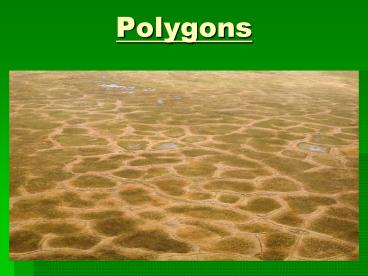Polygons - PowerPoint PPT Presentation
1 / 17
Title: Polygons
1
Polygons
2
Outline
- Definitions
- Periglacial
- Patterned Ground
- Polygons
- Types and Formation Theories
- Extraterrestrial
3
Periglacial Environments
- A number of definitions
- Definition from Physical Geography.net Landforms
created by processes associated with intense
freeze-thaw action in high latitude areas or near
an alpine or continental glacierFeatures
Include - Pingos
- Ice wedges
- Thermokarsts
- Patterned ground
- Polygons are a type of patterned ground
4
Polygons
- Non-sorted Are polygonal-shaped features often
delineated with a furrow or crack but without a
border of stonesvegetation is frequently
concentrated in the furrow and helps to emphasize
the pattern (Price 1972). - Usually found on near horizontal surfaces but
may be found on slopes. - Occur only in groups
- Range in size from a few cm up to 100m in
diameter. - Similar to mud beds but on a larger scale
- Largest size polygons are the result of ice
wedges.
- Sorted are Polygonal features given definition
by a border of stones surrounding a central area
of finer material (Price 1972). - Form on fairly level ground
- Small to large sizes from 10cm-10m in diameter.
- Occur in groups
- Stone size in the border increases with the size
of the feature and decreases with depth. - Stones on border are often on their edge and
oriented parallel to the border, which may or may
not be coincident with crack patterns.
5
Polygon Formation
- Usually the result of cracking due to dessication
or thermal contraction. - Cracks are vertical and are a result of
horizontal contraction of the surface layer. - Sorting sometimes occurs by movement of coarse
material towards and into the cracks. - In an experiment by Pissart (1974) in which the
ground was artificially leveled and mixed found
that it took small stones two years to accumulate
on the surface and those that did moved toward
and eventually fell into thermal contraction
cracks. This material was caused when the ground
warms and expands. Fine grained material below
the polygon is pushed upward and inward.
Eventually stones reach the surface of the
raised, fine grained material and gradually fall
into the bordering cracks. The process then
continues.
6
Types of Polygons
- There is a variety of polygon formations
- Different types may include
- Frost-crack polygons
- Ice-wedge polygons
- Sorted and non-sorted circles
- Stone or soil stripes
7
Frost Crack Polygon
- Frost cracks are steep fractures formed by
thermal contraction in rock or frozen ground with
substantial ice content. They commonly intersect
to create polygonal patterns, which may lead to
the formation of wedges of ice and surficial
material. The frequency of cracking is linked to
the intensity of winter cold.. - (http//www.gcrio.org/geo/frozen.html)
- Pic(http//uregina.ca/sauchyn/geog323/419.jpg)
8
Ice Wedge Polygons
- Begin with cracking due to intense cold and
thermal contraction. - The cracks gradually fill with ice
- The vertical wedges of ice shape the polygons
which occur below the active seasonal freeze-thaw
layer. - The visible surface formation is a result of the
soil slumping above the ice wedges. - (Williams and Smith 1989)
- May be a few metres to over 100 metres in
diameter. - Can form low-centered or high centered polygons
- Low centered if ice wedge is growing
- High centered if thawing and erosion are more
prevalent causing stream channels along ice-wedges
9
Sorted and Non-sorted Circles
- Sorted
- http//www.ucsc.edu/currents/02-03/art/patterns.03
-01-20.240.jpg
- Non-sorted
- www.//uregina.ca/sauchyn/geog323
10
Sorted and Non-Sorted Circles -Some classify
them as a separate category
- Sorted
- Have a definite ring of stones or rocks in a
circular formation - Defined as circular accumulations of stones
around a center of finer material. - Vary in size from a few centimeters to over 3m on
diameter and can extend to depths of about 1m. - Stones are largest at the surface and decrease
with depth. - Occur singly or in groups on horizontal surface.
- If the surface is not horizontal, elongation may
occur creating stripes.
- Non-sorted
- Lack definite ring of stones.
- Classified as bare circular areas margined by
vegetation (Price,1972). - Usually 0.5-3m in diameter.
- Can be found singly or in groups on fairly level
ground.
11
Stone Stripes
12
Stripes
- One definition of stripes is linear patterns of
soil or vegetation on slopes without related
lines of stonesfrequently consist of parallel
lines of vegetation and intervening strips of
relatively bare ground oriented down the steepest
slope ??? (Price, 1972) - Are believed to be created as stone circles but
elongate due to slope and creep.
- Range in size from a few cm to 1-2m in width and
can extend down slope several tens of metres but
are often discontinuous. - Can be sorted or unsorted
- Sorted Stripes often have stones turned on edge
parallel to the stripe.
13
Extraterrestrial
- Mars
- Have identified three types
- Small Scale
- Large Scale polygonal nets on level terrain
- Large scale polygonal nets in craters
- Are thought to be caused from freeze and thaw
frost cracking
14
Mars impact Crater Polygon Formations-Each
section slightly larger than a football
field(http//www.msss.com/mars_images/moc/7_19_99
_fifthMars/07_npolys)
15
- (A) Polygon troughs highlighted by frost as the
south polar cap retreats during spring. The
circular features are the locations of buried
craters that were originally formed by meteor
impact. This image was acquired on 1 October
2001. - (B) Summertime view of polygons, highlighted by
dark, windblown sand, on the floor of a crater.
Obtained on 21 January 2002. - (C ) Polygon troughs highlighted by the
retreating south polar frost cap during southern
summer. This picture was taken on 13 January
2000. - (A)
(B)
(C ) -
16
Cycle of polygons, thermokarst lakes and
pingoshttp/arctic.fws.gov/permcycl.htm
17
Thank You!www.isgs.uiuc.edu/quaternary/valleytra
in.html

